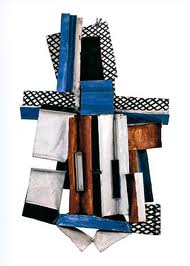This question popped into my mind during a recent tour of the Picasso exhibit at the Virginia Museum of Fine Arts in Richmond while listening to commentary from art historians and jazz musicians and noting how often he portrayed musical instruments and musicians. "Masterpieces from the Musee National Picasso in Paris" tracks the legendary artist through more than eight decades of work with nearly two hundred paintings and sculptures as well as black and white photos (silver gelatin prints) and printed materials.
Piccasso (and Georges Braque) explored what became known as cubism, confounding fellow artists and the larger world of popular culture at the turn of the 20th century. As one commentator said, "Just when you think you know what follows, he fools you." Another noted that Picasso moved from one personal artistic period to the next and from one medium to the next because he was always fighting convention, always seeking to reinvent himself and his art. The exhibit included "Man with a Guitar" (1911) and a three-dimensional wall hanging (part sculpture, part painting) in which Picasso bent and folded sheet metal and then painted it.
The Violin, among other pieces, helped me see the process of disassembling the components of an object then reassembling them to create a new reality with ties to the original image or object.
From the program guide: Rather than representations of reality, these works offered alternative realities where the perceptions of the world were presented as an assembly of simplified volumes, shifting planes and transparent surfaces.
Offering alternative realities seem to me to be the essence of art, whether it is writing words or interpreting music.
The cubist instruments like Man with Clarinette also showed the inherent playfulness in most of Picasso's work (the war images are something else). It's easy to picture him offering his latest guitar painting and laughing at the visitor's surprise when it is unveiled.
At times during the audio tour, musicians compared Picasso's evolution to the improvising of Jazz and there were pictures of the artist in Paris cafes surrounded by musicians. I haven't discovered if Picasso played an instrument but it is clear from his many paintings of guitars, banjos, violins and pianos that he loved and revered music and the ability to play it...his instruments seem like modern religious icons (or a protest against the sacred icons that dominated the history of western art?).
Picasso was always pushing boundaries and fighting against limits (and oppressive regimes). He fancied himself as a matador (in a marvelous self-portrait in the collection) and a rebel who was determined to do things his own way and wait for the world to accept it as the next big thing in art.
The sleepy music and culture of the post war fifties needed a creative spark to get the fires of the sixties burning. It is perhaps too big a leap to prove but I have a feeling if you asked Picasso if he caused the modern revolution in art and music, his response would be "Mai Oui!"
The Picasso exhibit in Richmond runs through May 15 (www.vmfa.state.va.us). The Museum of Modern Art (NYC) is currently offering its own show, Picasso Guitars 1912-1914 through June 6, 2011 (www. MOMA.org)




I prefer to think the cubist art of Picasso and the unconventional "music" of John Cage are related.
ReplyDeleteNice essay. Kind of get a Miles Davis vibe, though Bruce's reference to Cage is a good one. Great piece in response to what must be a wonderful exhibition.
ReplyDelete